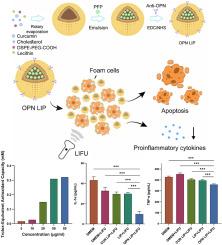超声响应骨桥蛋白靶向脂质体共同递送姜黄素和全氟正戊烷用于动脉粥样硬化治疗
IF 4.9
3区 医学
Q1 PHARMACOLOGY & PHARMACY
Journal of Drug Delivery Science and Technology
Pub Date : 2025-09-04
DOI:10.1016/j.jddst.2025.107486
引用次数: 0
摘要
骨桥蛋白(Osteopontin, OPN)在泡沫细胞中高度表达,是动脉粥样硬化斑块的标志,也是位点特异性药物递送的潜在靶点。在这项研究中,我们开发了OPN靶向脂粒(OPN LIP),共负载姜黄素和全氟正戊烷(PFP),以提高对动脉粥样硬化的治疗效果。脂质体具有均匀的粒径、胶体稳定性、良好的生物相容性和最小的细胞毒性。体外实验表明,ox- ldl刺激的RAW264.7泡沫细胞的细胞摄取效率高,且具有时间依赖性。暴露于低强度聚焦超声(LIFU)下,纳米载体发生声空化诱导破裂,导致姜黄素快速释放并显著诱导细胞凋亡。OPN - LIP显著降低泡沫细胞IL-1α和TNF-α水平,加重泡沫细胞凋亡。转录组学分析显示炎症和凋亡通路的调节,包括TLR、NF-κB和Mapk3信号通路。这些发现强调了OPN LIP作为一种超声响应的靶向纳米平台的潜力,能够抑制炎症和泡沫细胞的活力,为通过物理和药物相结合的策略治疗动脉粥样硬化提供了一种有希望的方法。本文章由计算机程序翻译,如有差异,请以英文原文为准。

Ultrasound-responsive osteopontin-targeted liposomes Co-delivering curcumin and perfluoro-n-pentane for atherosclerosis therapy
Osteopontin (OPN), highly expressed in foam cells, serves as a hallmark of atherosclerotic plaques and a potential target for site-specific drug delivery. In this study, we developed OPN-targeted liposomes (OPN LIP) co-loaded with curcumin and perfluoro-n-pentane (PFP) to enhance therapeutic efficacy against atherosclerosis. The liposomes exhibited uniform particle size, colloidal stability, favorable biocompatibility, and minimal cytotoxicity. In vitro experiments demonstrated efficient and time-dependent cellular uptake by ox-LDL–stimulated RAW264.7 foam cells. Upon exposure to low-intensity focused ultrasound (LIFU), the nanocarriers underwent acoustic cavitation-induced rupture, leading to rapid curcumin release and significant induction of apoptosis. OPN LIP treatment notably reduced IL-1α and TNF-α levels and aggravated apoptosis in foam cells. Transcriptomic analysis revealed modulation of inflammatory and apoptotic pathways, including TLR, NF-κB, and Mapk3 signaling. These findings highlight the potential of OPN LIP as an ultrasound-responsive, targeted nanoplatform capable of suppressing inflammation and foam cell viability, providing a promising approach for the treatment of atherosclerosis through combined physical and pharmacological strategies.
求助全文
通过发布文献求助,成功后即可免费获取论文全文。
去求助
来源期刊
CiteScore
8.00
自引率
8.00%
发文量
879
审稿时长
94 days
期刊介绍:
The Journal of Drug Delivery Science and Technology is an international journal devoted to drug delivery and pharmaceutical technology. The journal covers all innovative aspects of all pharmaceutical dosage forms and the most advanced research on controlled release, bioavailability and drug absorption, nanomedicines, gene delivery, tissue engineering, etc. Hot topics, related to manufacturing processes and quality control, are also welcomed.

 求助内容:
求助内容: 应助结果提醒方式:
应助结果提醒方式:


